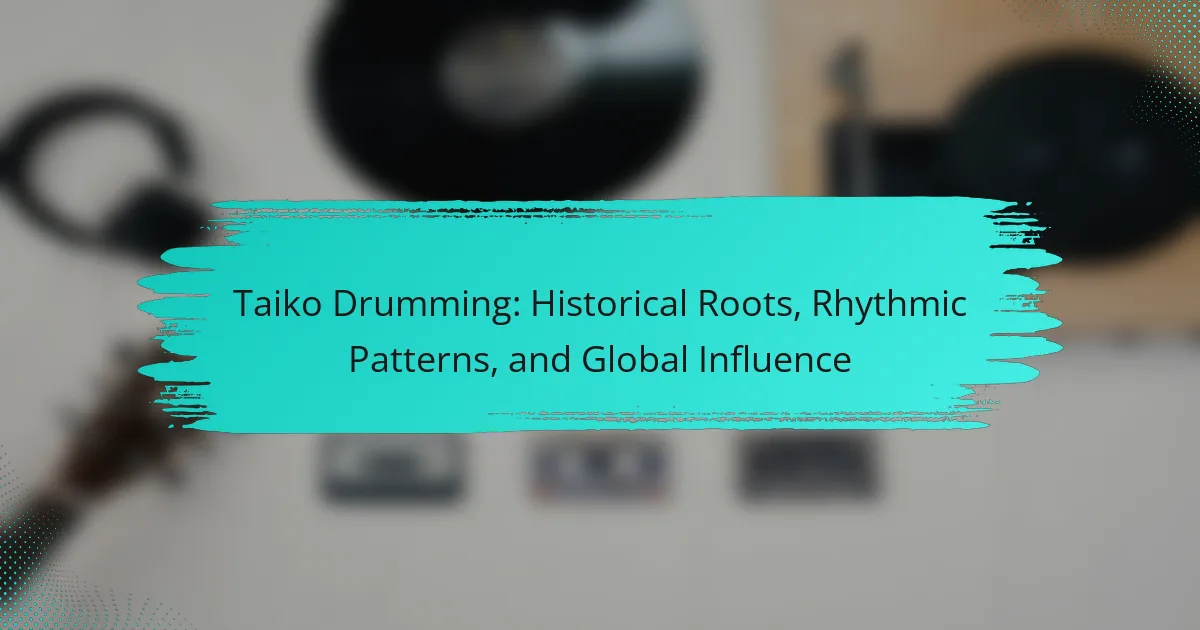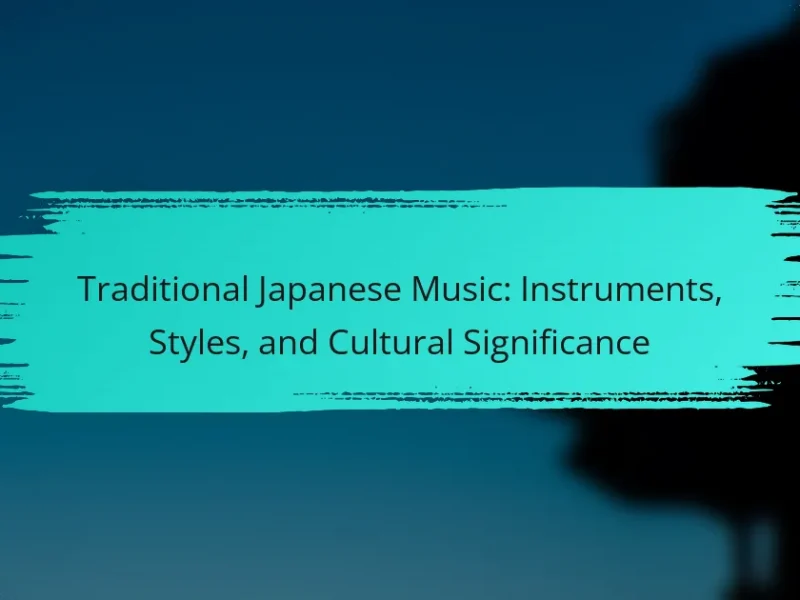Taiko drumming offers physical fitness, cultural appreciation, and community engagement. This article explores its historical roots in Japan, diverse rhythmic patterns, and global influence on music. Key techniques and instruments are highlighted, along with the challenges faced in modern contexts and resources for aspiring drummers.

How has Taiko Drumming evolved through history?
Taiko drumming has evolved significantly from its origins in Japan to its global presence today. Initially used for communication and religious ceremonies, taiko has transformed into a performance art.
Throughout history, taiko drumming has incorporated various rhythmic patterns, reflecting regional influences and cultural exchanges. Traditional styles, such as Kumi-daiko, emphasize group performance, while contemporary adaptations include fusion with other musical genres.
The global influence of taiko is evident in its adoption by diverse communities, leading to the establishment of taiko ensembles worldwide. This evolution showcases the adaptability of taiko, allowing it to resonate with audiences beyond its cultural roots.
What are the cultural origins of Taiko Drumming?
Taiko drumming has origins in Japan, dating back to ancient times as a form of communication and ritual. It evolved through various historical periods, including its use in agriculture, military, and religious ceremonies. The unique attributes of Taiko include its diverse rhythmic patterns and the use of large drums, which create powerful sounds. Today, Taiko has a global influence, inspiring fusion with other musical genres and cultural expressions, showcasing its adaptability and appeal beyond its traditional roots.
Which historical events influenced the development of Taiko Drumming?
Taiko drumming evolved through various historical events, notably its use in agriculture, warfare, and festivals. Initially, it served as a communication tool in rice farming, signaling planting and harvesting times. During the Edo period, Taiko became integral to military strategy, enhancing troop morale and coordination. Additionally, festivals incorporated Taiko to celebrate local deities, fostering community spirit. These influences shaped Taiko’s rhythmic patterns and cultural significance, leading to its global recognition today.
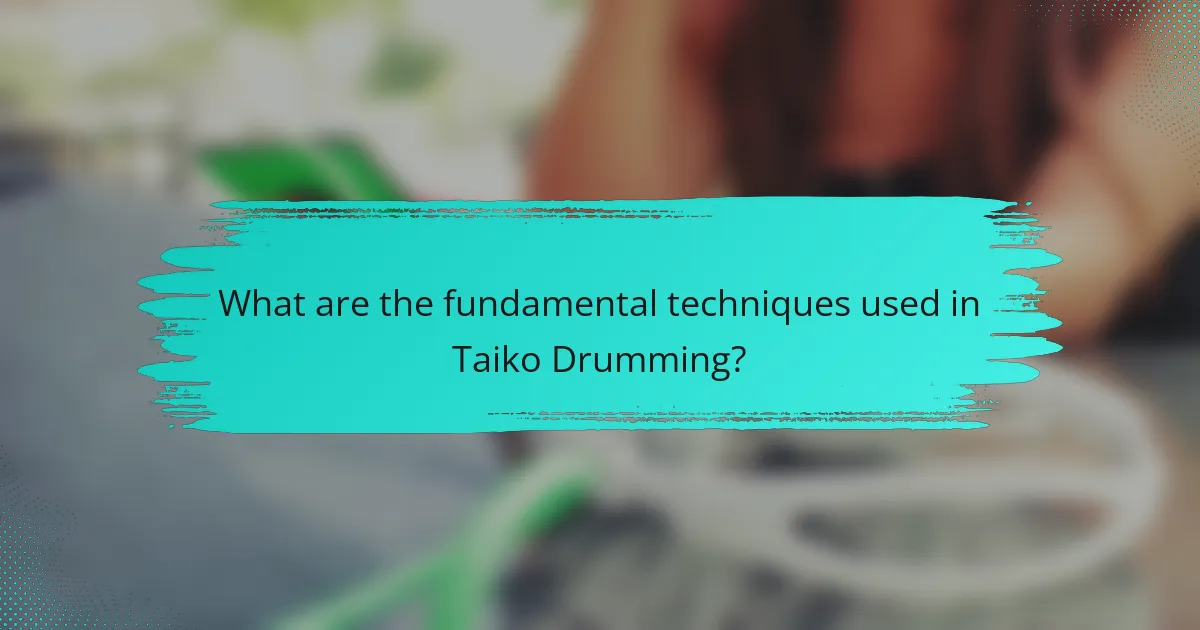
What are the fundamental techniques used in Taiko Drumming?
Taiko drumming techniques include precise striking, rhythmic coordination, and dynamic movement. These techniques emphasize strong, synchronized beats and the use of various drum sizes to create diverse soundscapes. Historical roots trace back to Japan, where taiko was used in festivals and rituals. The global influence of taiko has led to its incorporation in contemporary music and performance art, showcasing its adaptability and appeal. Key techniques involve the use of bachi (drumsticks) for striking, body posture for resonance, and choreographed group performances that enhance visual impact.
How do different playing styles impact performance?
Different playing styles significantly impact performance in taiko drumming by influencing rhythm, dynamics, and expression. For instance, a traditional style emphasizes precision and adherence to historical techniques, enhancing authenticity. In contrast, a contemporary style allows for personal expression, fostering creativity and innovation. Each style shapes how drummers interpret rhythms, affecting overall sound and audience engagement. The choice of style can also dictate physical techniques, which may lead to variations in stamina and endurance during performances.
What role does rhythm play in Taiko Drumming?
Rhythm is fundamental in Taiko drumming, establishing the core structure and energy of performances. It influences the emotional impact and synchronization among drummers, creating a powerful communal experience. Traditional patterns like “ichiban” and “niban” showcase distinct tempos and dynamics, emphasizing cultural storytelling. The rhythmic complexity fosters both individual expression and group cohesion, making rhythm essential to Taiko’s global influence and appeal.
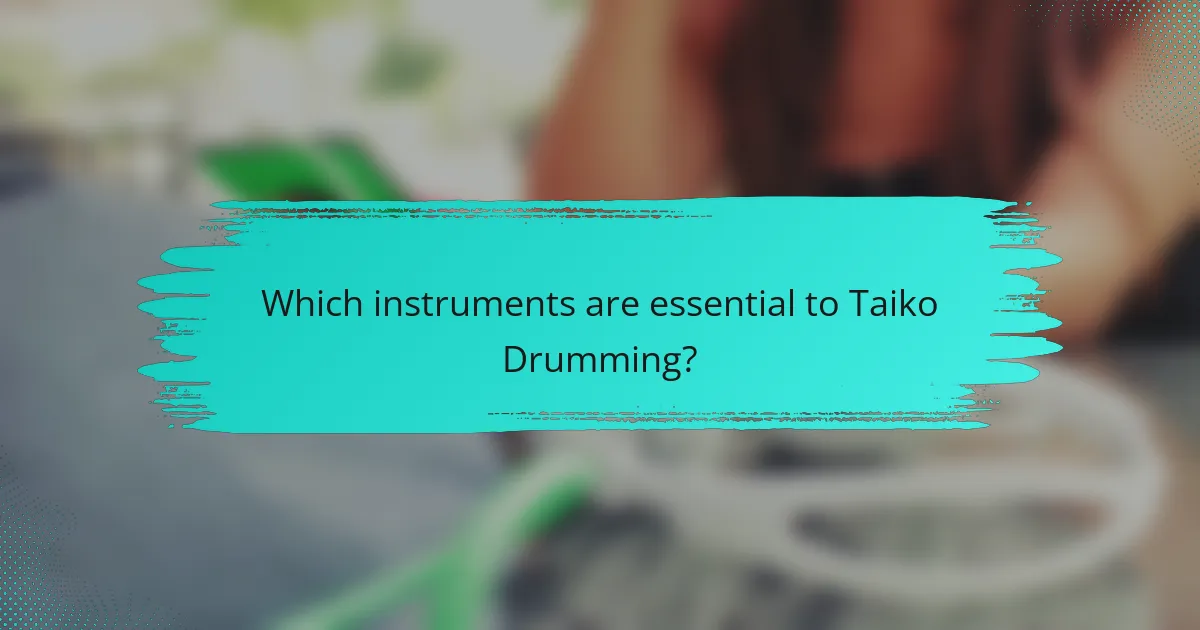
Which instruments are essential to Taiko Drumming?
Essential instruments for Taiko drumming include the nagado-daiko, shime-daiko, and o-daiko. The nagado-daiko serves as the main drum, characterized by its large, deep sound. The shime-daiko features a higher pitch, often used for intricate rhythms. The o-daiko, a massive drum, produces powerful, resonant tones essential for ensemble performances. Each instrument contributes unique attributes to the overall Taiko experience, emphasizing rhythm and cultural expression.
How does the construction of Taiko drums affect sound quality?
The construction of Taiko drums significantly influences sound quality. Factors such as wood type, thickness, and tension of the drumhead affect resonance and tonal clarity.
Traditional Taiko drums, often made from specific hardwoods, produce a rich, deep sound. The unique attribute of the drum’s shape, typically wider at the top, enhances projection. Drumhead tension, adjusted during construction, alters pitch and sustain.
Moreover, the rare attribute of using animal skin versus synthetic materials can create distinct tonal differences. These construction elements collectively determine the drum’s overall sound character, impacting performance in various musical contexts.
What variations exist among Taiko drum types?
Several variations exist among Taiko drum types, each with distinct characteristics. The most common types include the Odaiko, a large drum used for powerful rhythms; the Chudaiko, a medium-sized drum known for its versatility; and the Shime-daiko, a smaller, high-pitched drum used for intricate patterns. Each type contributes uniquely to the overall sound and performance of Taiko drumming, reflecting regional styles and historical influences.

What are the key performance elements in Taiko Drumming?
Key performance elements in Taiko drumming include rhythm, technique, physicality, and expression. Rhythm is foundational, driving the performance’s energy. Technique encompasses stick handling and body movement. Physicality involves stamina and strength, while expression conveys emotion and cultural significance. Each element contributes to the overall impact of the performance, showcasing the art form’s depth.
How does choreography enhance Taiko performances?
Choreography enhances Taiko performances by adding visual storytelling and synchronized movements. This integration captivates audiences and emphasizes the rhythm and energy of the drumming. The dynamic interplay between choreography and drumming creates a holistic experience, showcasing the cultural significance of Taiko. Additionally, choreographed movements can highlight the unique attributes of each performer, making each performance distinct.
What is the significance of ensemble playing in Taiko Drumming?
Ensemble playing in Taiko drumming fosters unity, enhances rhythm, and amplifies sound. It cultivates teamwork, allowing drummers to synchronize their movements and create intricate patterns. This collaborative approach enriches performances, showcasing the cultural significance of Taiko as a communal art form. The dynamic interplay among performers highlights the root attribute of Taiko drumming, which is its emphasis on collective expression.

How does Taiko Drumming influence global music cultures?
Taiko drumming significantly influences global music cultures through its unique rhythms and collaborative spirit. Originating in Japan, taiko has evolved, incorporating diverse musical styles and techniques. Its powerful beats resonate in various genres, from jazz to pop, inspiring musicians worldwide. The communal aspect of taiko fosters unity, encouraging cross-cultural collaborations and performances. As a result, taiko drumming enriches global music by blending traditional and contemporary elements, showcasing its adaptability and universal appeal.
Which international festivals celebrate Taiko Drumming?
International festivals that celebrate Taiko Drumming include the Los Angeles Taiko Festival, the San Francisco Taiko Dojo’s annual performances, and the Tokyo Taiko Festival. These events showcase traditional performances and foster cultural exchange. The unique rhythms and community spirit of Taiko are highlighted, attracting participants and audiences globally.
What are the cross-cultural collaborations involving Taiko Drumming?
Cross-cultural collaborations involving Taiko drumming showcase its global appeal and adaptability. These projects often blend traditional Japanese rhythms with various musical styles worldwide. Notable examples include collaborations with African drumming, jazz ensembles, and contemporary dance companies. Such partnerships enhance cultural exchange and foster appreciation for Taiko’s unique rhythmic patterns. Events like the Taiko Festival further highlight these collaborations, bringing together artists from diverse backgrounds to celebrate this dynamic art form.

What are the benefits of learning Taiko Drumming?
Learning Taiko Drumming offers numerous benefits, including physical fitness, cultural appreciation, and community engagement. It enhances coordination and rhythm while promoting teamwork and discipline. Taiko drumming also fosters emotional expression and stress relief. Additionally, it connects practitioners to Japanese traditions, enriching their cultural understanding.
How does Taiko Drumming contribute to physical fitness?
Taiko drumming significantly enhances physical fitness by promoting cardiovascular health, strength, and coordination. The vigorous movements involved in playing the drums elevate heart rates, improving endurance. Additionally, the full-body engagement strengthens muscles, particularly in the arms, core, and legs. Regular practice can lead to improved balance and coordination through rhythmic patterns and movements. This form of exercise is not only enjoyable but also provides a unique cultural experience that contributes to overall well-being.
What mental health benefits are associated with Taiko Drumming?
Taiko drumming offers several mental health benefits, including stress reduction, improved mood, and enhanced focus. Engaging in this rhythmic practice fosters a sense of community and belonging. The physical activity involved releases endorphins, promoting emotional well-being. Additionally, the meditative aspect of drumming can help reduce anxiety and improve mindfulness, contributing to overall mental resilience.
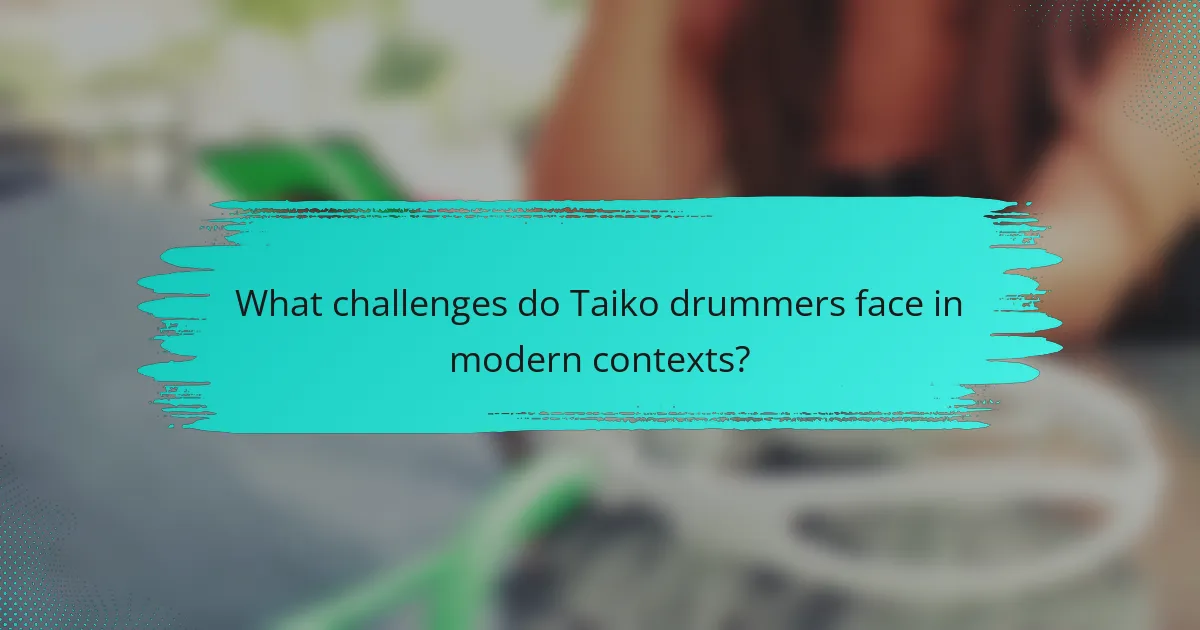
What challenges do Taiko drummers face in modern contexts?
Taiko drummers face several challenges in modern contexts, including cultural preservation, commercialization, and physical demands. Cultural preservation involves maintaining traditional techniques while adapting to contemporary influences. Commercialization can dilute authenticity, as performances may prioritize entertainment over traditional values. Additionally, the physical demands of taiko drumming require rigorous training, which can lead to injuries if not managed properly. These challenges impact the evolution and perception of taiko as both an art form and a cultural expression.
How do cultural appropriation concerns affect Taiko Drumming?
Cultural appropriation concerns can limit the global appreciation of Taiko drumming. This traditional Japanese art form has deep historical roots and is often viewed through cultural sensitivity lenses. As Taiko expands internationally, debates arise over authenticity and respect for its origins. Artists may face scrutiny regarding their representation and interpretation of Taiko, which can affect collaborations and performances. Understanding these dynamics is crucial for fostering respectful cultural exchange while preserving the integrity of Taiko drumming.
What are the common misconceptions about Taiko Drumming?
Many misconceptions surround Taiko drumming, often oversimplifying its cultural significance and technical complexity. One common myth is that Taiko is solely a performance art; in reality, it encompasses spiritual and community elements. Another misconception is that all Taiko drumming is loud and aggressive; however, it features a wide range of rhythms and dynamics. Additionally, some believe Taiko drumming originated in Japan alone, while it actually has various roots across Asia. Lastly, many think Taiko requires years of training to enjoy; beginners can participate in accessible workshops and classes.
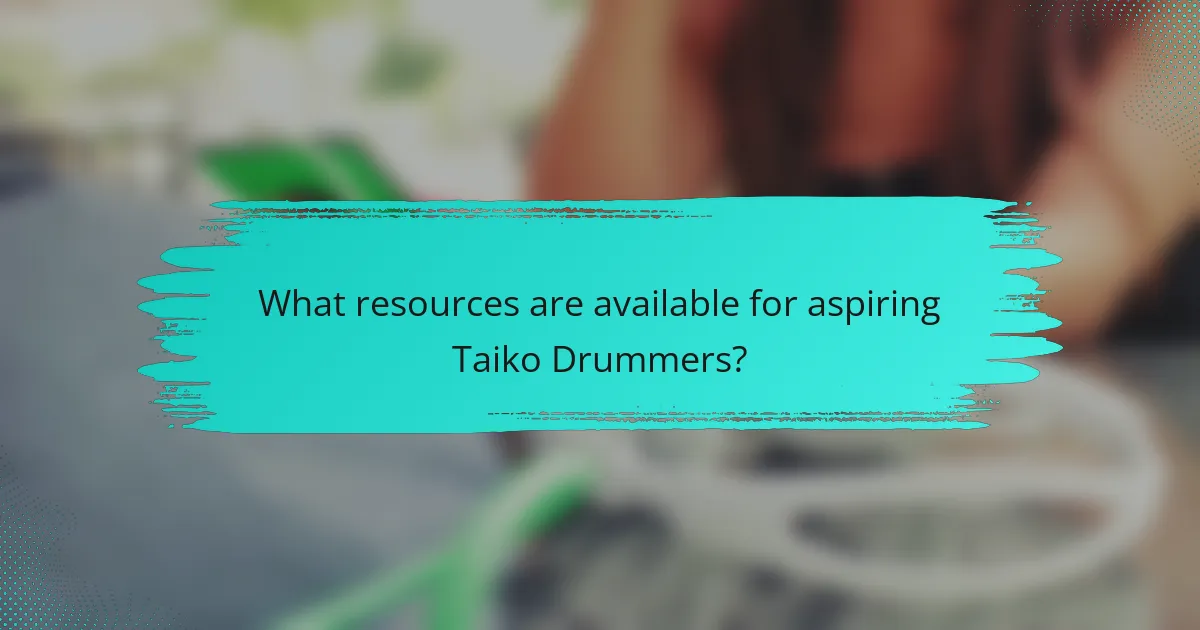
What resources are available for aspiring Taiko Drummers?
Aspiring Taiko drummers can access various resources to enhance their skills. Local workshops and classes often provide hands-on experience with expert instructors. Online platforms offer instructional videos and tutorials tailored for different skill levels. Books and manuals on Taiko history and techniques serve as valuable references. Additionally, community groups and social media forums foster connections and share practice tips among drummers. Engaging with these resources supports the development of rhythmic patterns and appreciation of Taiko’s global influence.
Which instructional materials are recommended for beginners?
For beginners in taiko drumming, recommended instructional materials include beginner-friendly books, online tutorials, and instructional DVDs. These resources provide foundational techniques, rhythmic patterns, and historical context.
1. “Taiko: The Art of Japanese Drumming” by Katsuji Abe – offers insights into techniques and history.
2. Online platforms like YouTube feature beginner tutorials demonstrating basic rhythms.
3. Instructional DVDs often include visual demonstrations and practice exercises.
These materials help beginners build essential skills and understand the cultural significance of taiko drumming.
What are the best practices for joining a Taiko group?
Joining a Taiko group requires dedication and a willingness to learn. Start by researching local groups and attending introductory workshops to understand the basics.
Next, focus on developing your rhythm and timing through practice. Regular participation in group sessions enhances your skills and builds camaraderie.
Be open to feedback from instructors and fellow drummers, as this will help you improve. Lastly, embrace the cultural aspects of Taiko, as understanding its historical roots enriches the experience.
What common mistakes should beginners avoid in Taiko Drumming?
Beginners in Taiko drumming should avoid common mistakes to enhance their learning experience. Key errors include neglecting proper posture, which can lead to fatigue and injury, and failing to listen to the rhythm, resulting in poor timing. Additionally, beginners often rush through practice sessions instead of focusing on technique and consistency. It’s crucial to avoid overexertion, as this can diminish enjoyment and lead to burnout. Lastly, skipping warm-ups can negatively impact performance and increase the risk of injury.
